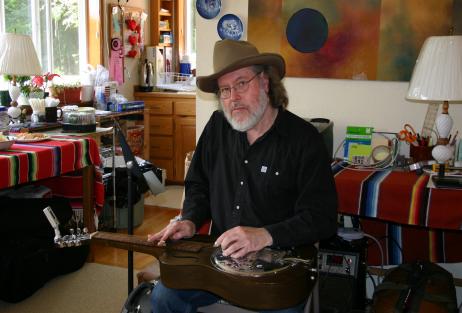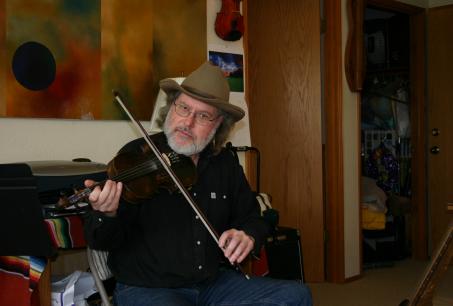Rich Ives: Searching the Boundaries
Flashback to 1973. Rich Ives is a young student in the Creative Writing program at Eastern Washington University. He has stacks of photos he’s taken of various subjects (coeds, mainly, in abstract postures) and a freezer full of cheap corn dogs. He plays keyboard in a rock blues band. We share an office as teaching assistants and travel the road with Professor Jim McAuley and Dick Hugo in the Poets in the Schools program. We are lean, mean, writing machines.
Now flash forward 40 years. He wears a cowboy hat and one earring and teaches creative writing and composition at Everett Community College (WA) as a tenured professor. His interest has grown to include visual art. I asked him how art and music cross over to each other and to his writing: “My written forms are not so much the usually named ones, but a searching at the boundaries of these elements applied in different contexts. In art, for example, I do collage and assemblage, which is associational to me, much as my writing is.”
He adds, “I am very texture oriented but not literal minded. I let the associations of objects in color, shape, touch, and mood guide me, with much experimentation and often with the happy discovery that there was a reason I wasn't aware of for choosing a relationship until it has already led me to a second or third association. The art is about making discoveries and using the physicality of words, which have different, if related, textures to what they name, to create suggestions and associations, especially context and emotional implications.”
His writing has been strongly influenced by “foreign imagery-based poets who are very tactile, and it has spread in what might seem like diverse directions, which are really related by voice, style, visual and symbolic focus, and point of view. I am as interested in what is implied in my work as what is said,” he clarifies.
He has over sixty musical instruments, currently concentrating on the fiddle, dobro, cittern, octave mandolin, and keyboards (piano, clavinet, organ, synthesized sounds, etc.). His style is from another era, notably old-time country music. “With the keyboards there’s a lot of variety, but I especially like jazz, blues, and ragtime.”
“In music I focus on expression and improvisation to imply parts of the ‘extended story,’” he explains. “I write in a similar manner, not primarily from ideas or plots, although these often emerge, but by letting tentative possibilities create and extend themselves by implication rather than explanation from combinations of words and images, and their creation of often unexpected contexts, into a larger series of implications. I often work episodically and focus on what I may be able to suggest “happens” between the episodes. Part of the art is trying to comprehend and extend what has been suggested beyond what has been said, to create a second story line. The art and music I work with approaches the same intention from an opposite direction, and these areas are overlapping more often now.”
He works a lot in flash fiction. This term is somewhat elastic but he describes it carefully: “Flash fiction started from an attempt to notice and separate what had started to establish itself as the prose poem in my writing from work based more on plot and character than language manipulations. I found the line between very difficult to locate, and I am often in the middle. I've adopted the term, used by Gunter Eich and Michael Benedikt, ‘mole’ for the hybrid forms I often create.”
Example:
“Story Too Short for Its Box”
Something was singing. I suspected my grocery bag. I suspected my tomato. It was the kind of song you hear the heroine singing when she’s in trouble on a mountaintop. Accompanied by a flinging of capes and two or three plain looking sisters with amazing harmony.
I tried on a different four-cornered hat.
My comedy shoes were bleeding. It was not quite ironic but leading to, and distended and hooked and intimated. It was the space above yesterday that I was missing, but today was filling it in. It was beautiful and it was an army training ground, and I was qualified. I didn't want to have to kill anyone, but I knew for that kind of beauty I should.
(from Alice Blue online lit mag)
When asked about his current project, he answered, “After finishing a long three-volume novel, I’ve turned to researching insects for a book that keeps growing, tentatively titled People You Thought You Knew: an Entomologist’s Guidebook to Human Behavior.”
He describes his reason for writing: “I write to find out who I am, to discover pieces of myself I didn’t know were there. In a sense, I write to become a bigger person. I try not to rely too much on what I know, but explore what I want to know and especially to find out why those particular things are the ones that draw me. I allow myself to become other people who have been hiding inside me as I do this. I've probably even dragged a few there that would have resisted if they realized what I was doing. I lose myself in them to find out what they’re doing there.”
And lastly, he has some words for young writers: “Most young writers don’t seem to be reading widely enough, especially in alternative forms and foreign writers, to break the stranglehold of the preconceptions so dominant in mainstream publishing and genre writing. The answers to questions a writer has about the work should mostly not be known before the work is in motion. It’s the excitement of following unknowns to potential knowns that creates the deeper thrust and surprising power of working your way out of the dark and into that particular work’s own best form.”
Rich Ives creates worlds of complexity and texture. His forthcoming books include: Sharpen (fiction chapbook), The Newer York Press, Tunneling to the Moon (short prose forms), Silenced Press; and Light from a Small Brown Bird (poetry), Bitter Oleander Press.
Anita Endrezze is a writer and artist. Her next book is a chapbook, “A Thousand Branches” (Red Bird Press, 2014), a book of poems and art. She was featured in issue 297.4 of the North American Review.
Recommended
Nor’easter
Post-Op Appointment With My Father
Cedar Valley Youth Poet Laureate | Fall 2024 Workshop







